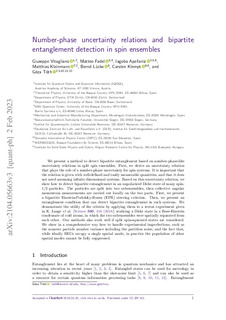| dc.rights.license | Attribution 4.0 International | * |
| dc.contributor.author | Apellaniz, Iagoba | |
| dc.contributor.other | Vitagliano, Giuseppe | |
| dc.contributor.other | Fade, Matteo | |
| dc.contributor.other | Kleinmann, Matthias | |
| dc.contributor.other | Lücke, Bernd | |
| dc.contributor.other | Klempt, Carsten | |
| dc.contributor.other | Tóth, Géza | |
| dc.date.accessioned | 2023-04-17T13:03:39Z | |
| dc.date.available | 2023-04-17T13:03:39Z | |
| dc.date.issued | 2023 | |
| dc.identifier.issn | 2521-327X | en |
| dc.identifier.other | https://katalogoa.mondragon.edu/janium-bin/janium_login_opac.pl?find&ficha_no=172453 | en |
| dc.identifier.uri | https://hdl.handle.net/20.500.11984/6073 | |
| dc.description.abstract | We present a method to detect bipartite entanglement based on number-phase-like uncertainty relations in split spin ensembles. First, we derive an uncertainty relation that plays the role of a number-phase uncertainty for spin systems. It is important that the relation is given with well-defined and easily measurable quantities, and that it does not need assuming infinite dimensional systems. Based on this uncertainty relation, we show how to detect bipartite entanglement in an unpolarized Dicke state of many spin-1/2 particles. The particles are split into two subensembles, then collective angular momentum measurements are carried out locally on the two parts. First, we present a bipartite Einstein-Podolsky-Rosen (EPR) steering criterion. Then, we present an entanglement condition that can detect bipartite entanglement in such systems. We demonstrate the utility of the criteria by applying them to a recent experiment given in K. Lange et al. [Science 360, 416 (2018)] realizing a Dicke state in a Bose-Einstein condensate of cold atoms, in which the two subensembles were spatially separated from each other. Our methods also work well if split spin-squeezed states are considered. We show in a comprehensive way how to handle experimental imperfections, such as the nonzero particle number variance including the partition noise, and the fact that, while ideally BECs occupy a single spatial mode, in practice the population of other spatial modes cannot be fully suppressed. | en |
| dc.language.iso | eng | en |
| dc.publisher | Quantum | en |
| dc.rights | © 2023 The Authors | en |
| dc.rights.uri | http://creativecommons.org/licenses/by/4.0/ | * |
| dc.title | Number-phase uncertainty relations and bipartite entanglement detection in spin ensembles | en |
| dc.type | http://purl.org/coar/resource_type/c_6501 | |
| dcterms.accessRights | http://purl.org/coar/access_right/c_abf2 | en |
| dcterms.source | Quantum | en |
| local.description.peerreviewed | true | en |
| local.identifier.doi | https://doi.org/10.22331/q-2023-02-09-914 | en |
| local.contributor.otherinstitution | https://ror.org/03anc3s24 | en |
| local.contributor.otherinstitution | https://ror.org/000xsnr85 | eu |
| local.contributor.otherinstitution | https://ror.org/05a28rw58 | de |
| local.contributor.otherinstitution | https://ror.org/02s6k3f65 | en |
| local.contributor.otherinstitution | https://ror.org/02azyry73 | de |
| local.contributor.otherinstitution | https://ror.org/0304hq317 | de |
| local.contributor.otherinstitution | https://ror.org/04bwf3e34 | de |
| local.contributor.otherinstitution | https://ror.org/02e24yw40 | en |
| local.contributor.otherinstitution | https://ror.org/01cc3fy72 | en |
| local.contributor.otherinstitution | https://ror.org/035dsb084 | en |
| local.source.details | Vol. 7. P. 914 | en |
| oaire.format.mimetype | application/pdf | en |
| oaire.file | $DSPACE\assetstore | en |
| oaire.resourceType | http://purl.org/coar/resource_type/c_6501 | en |
| oaire.version | http://purl.org/coar/version/c_970fb48d4fbd8a85 | en |








